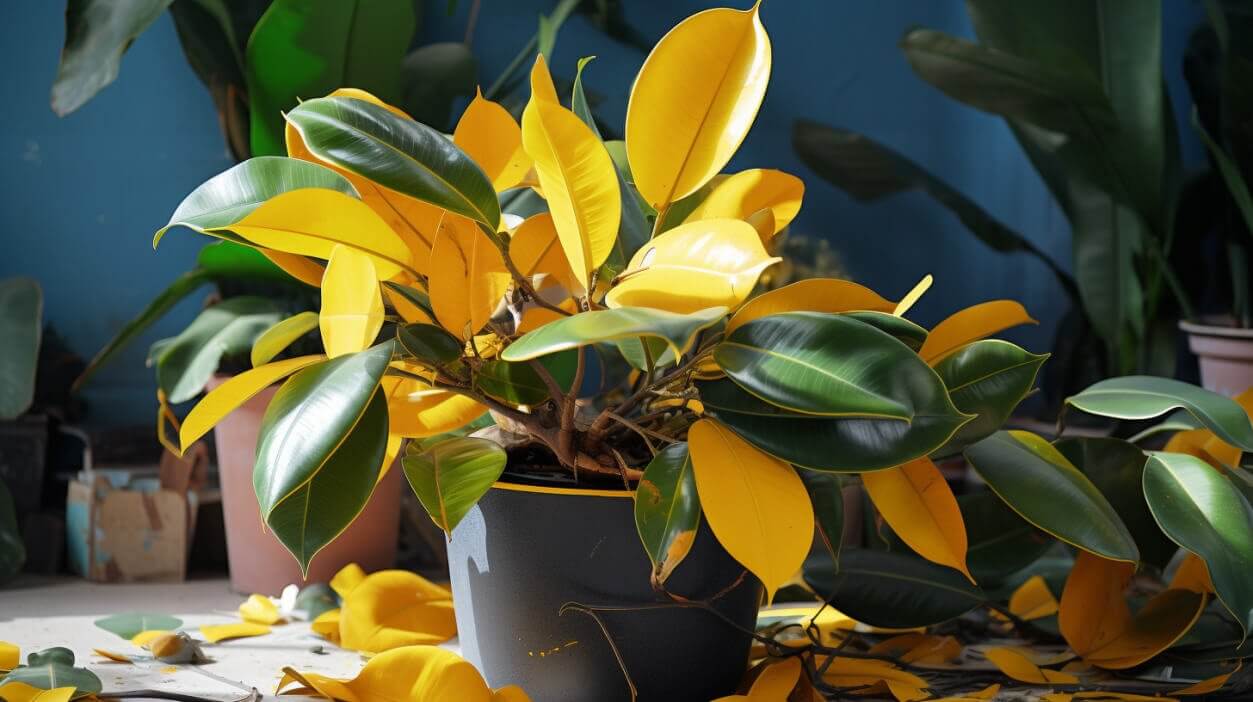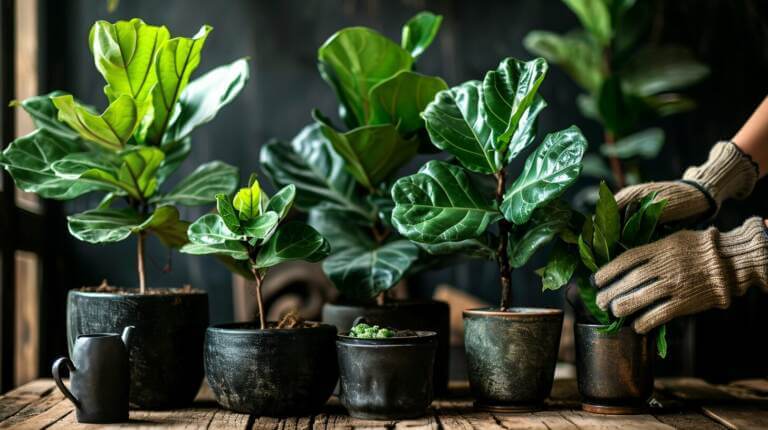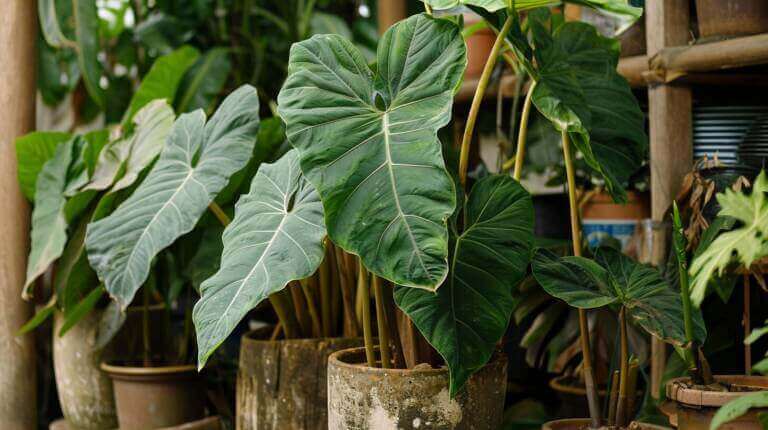Common Causes of Rubber Plant(Ficus elastica) Leaf Drop
Change in lighting as a common reason
Hey there fellow houseplant enthusiasts! Have you noticed your rubber plant shedding some leaves lately? Don’t panic! Leaf drop is a common issue that rubber plant owners face. One of the possible causes could be a change in lighting conditions.
Tropical plants, such as Rubber plants, thrive in bright, indirect light. If you recently moved your plant to a different spot, it may not be getting enough light or receiving too much direct sunlight, causing stress to the plant. Remember, these plants prefer consistency and can be sensitive to sudden changes. So, find a spot with the right balance of light and make sure to rotate your plant periodically for even growth.
Overwatering or improper watering and draining techniques
Hi plant lovers! If your rubber plant looks droopy and its leaves are turning yellow or falling off, the issue might be related to watering. Overwatering or improper watering and draining techniques can cause stress to the roots, leading to leaf drop.
Rubber plants prefer well-draining soil and evenly moist conditions. Allow the top inch of soil to dry out before watering again. Remember, it’s essential to strike a balance because both underwatering and overwatering can cause leaf drop. Make sure the pot has drainage holes to prevent waterlogged soil and check the roots for signs of rot.
Keep in mind, when you see yellow leaves falling, think of it as your rubber plant’s way of communicating its needs. Be patient! With the right care, your plant will bounce back and continue to thrive. Keep an eye on lighting conditions, provide proper watering, and ensure good drainage. And remember, you got this – you’re the plant parent your rubber plant needs!
Quick Fixes for Rubber Plant Leaf Drop
Balancing water temperature, soil conditions, and sunlight
I love my rubber plant, but recently I noticed that it has been dropping leaves. After some research, I discovered that there could be a few reasons behind this issue. The first thing to check is the balance between water temperature, soil conditions, and sunlight.
Rubber plants thrive in warm temperatures, between 60-80°F (15-27°C). If the room is too cold or drafty, it can cause stress to the plant, leading to leaf drop. Make sure to keep your rubber plant away from cold drafts and chilly windows.
Similarly, soil conditions play a vital role in the health of your rubber plant. Overwatering or underwatering can cause leaf drop. The soil should be moist but never soggy. Check the moisture level regularly by sticking your finger about an inch into the soil. If it feels dry, it’s time to water. Additionally, ensure adequate drainage to prevent waterlogging, which can suffocate the roots.
Lastly, sunlight is crucial for the rubber plant’s growth. It thrives in bright, indirect light, but direct sunlight can scorch its leaves. If your plant is placed in a spot with too much direct sunlight, it may start dropping leaves. Move it to a location with filtered or indirect sunlight to help it recover.
Ensuring proper watering and drainage techniques
One of the most common reasons for leaf drop in rubber plants is improper watering and drainage techniques. Here are some quick fixes you can implement:
- Set a watering schedule: Develop a routine to water your rubber plant consistently. Avoid erratic watering, as it can stress the plant. Aim to water it once the soil surface starts to dry out.
- Use the right pot and potting mix: Ensure your rubber plant is in a well-draining pot with a suitable potting mix. A mix of peat moss, perlite, and vermiculite can provide the proper drainage required for the plant’s roots.
- Adjust watering frequency: If you find that you are consistently over or underwatering your rubber plant, adjust the watering frequency accordingly. Each plant is unique, so pay attention to its specific needs.
By following these quick fixes, you can help prevent leaf drop in your rubber plant and ensure its overall health and beauty. Remember, with a little care and attention, your rubber plant will continue to bring joy and vibrancy to your living space.
Without a doubt, maintaining indoor plants can bring joy and beauty to any space. However, it can sometimes be frustrating when the leaves of your rubber plant start dropping unexpectedly. I know this because I’ve experienced it myself. But fear not! There are several common causes for rubber plant leaf drop and quick fixes to get your plant back on track.
Understanding the reasons behind rubber plant leaf drop
- Lack of water: Rubber plants prefer moist soil, but be careful not to overwater as it can lead to root rot. Check the moisture level of the soil regularly and adjust your watering schedule accordingly.
- Insufficient light: Rubber plants thrive in bright, indirect light. If your plant is not getting enough light, it may drop leaves. Try moving it to a spot near a window or invest in artificial grow lights.
- Temperature fluctuations: Rubber plants prefer consistent temperatures between 60°F and 75°F (15°C to 24°C). Avoid placing your plant near drafts or heat sources as it can cause stress and leaf drop.
Implementing quick fixes for healthy and thriving rubber plants
- Adjust watering: Ensure that you’re providing adequate water to your rubber plant. Water it thoroughly until water drains out of the bottom of the pot, then allow the top inch of soil to dry before watering again.
- Provide proper lighting: Move your rubber plant to a location with bright, indirect light. If natural light is limited, consider using artificial grow lights placed about 12 inches above the plant.
- Maintain consistent temperature: Keep your rubber plant away from drafts and extreme temperature changes. If necessary, use a humidifier to create a stable environment.
By understanding the reasons behind rubber plant leaf drop and implementing these quick fixes, you can help your plant thrive. Remember, plants need time to recover, so be patient and observe the changes. Having a healthy and beautiful rubber plant is definitely worth the effort.
FAQ
Why is my rubber plant dropping leaves?
There can be several reasons why your rubber plant is dropping leaves. It could be due to environmental factors, such as low humidity, overwatering, or lack of sunlight. Other possible causes include pests, infrequent watering, or a lack of nutrients.
How can I prevent my rubber plant losing leaves?
To prevent your rubber plant from losing leaves, make sure to provide it with the right conditions. Keep the humidity levels around the plant between 40-60%. Water your plant regularly, but avoid overwatering. Place it in a spot that receives bright, indirect sunlight. Additionally, inspect your plant regularly for signs of pests and take immediate action if you spot any.
Can pests cause my rubber tree plant to drop leaves?
Yes, pests like spider mites, mealybugs, and scale insects can infest your rubber plant and cause it to drop leaves. These pests feed on the leaves and stems, weakening the plant and causing leaf loss. It is essential to regularly inspect your plant for any signs of pests and take appropriate measures to eliminate them.
What should I do if my rubber plant’s leaves are falling off?
If your rubber plant’s leaves are falling off, first check the environmental conditions. Ensure that the humidity levels around the plant are adequate and the amount of sunlight it receives is appropriate. Review your watering routine and adjust if necessary. If you suspect pests, inspect the plant thoroughly and treat it accordingly.
Are rubber plants sensitive to humidity?
Yes, rubber plants thrive in high humidity environments. Low humidity can cause the leaves to droop and eventually drop. To provide adequate humidity, you can use a humidifier, place the plant on a tray filled with water and pebbles, or mist the leaves regularly.
How often should I water my rubber plant?
The frequency of watering your rubber plant depends on multiple factors such as the size of the plant, pot size, and environmental conditions. As a general guideline, allow the top inch of soil to dry between waterings. Stick your finger into the soil to check the moisture level before watering.
Is it normal for my rubber plant to lose leaves when I first bring it home?
Yes, it is normal for a rubber plant to drop a few leaves when it is adjusting to a new environment. The change in lighting, humidity, and temperature can cause temporary stress to the plant. However, if the leaf loss continues for an extended period or the plant appears unhealthy, it might indicate other underlying issues that need attention.
Can damaged leaves on my rubber plant recover?
Damaged leaves on your rubber plant generally do not recover. Once a leaf is damaged or yellowed, it is best to remove it from the plant. This will allow the plant to direct its energy towards healthy new growth and also prevent the spread of any diseases or pests that might be affecting the damaged leaves.
What are some common care tips for a healthy rubber plant?
To keep your rubber plant healthy, provide it with bright, indirect sunlight. Keep the soil moist but not waterlogged, and water only when the top inch of soil is dry. Maintain moderate to high humidity levels around the plant. Regularly dust the leaves to keep them clean and free from pests. Prune the plant as needed to maintain its shape and remove any dead or damaged leaves.
Why are the leaves on the base of my rubber plant falling off?
The leaves on the base of a rubber plant may fall off due to natural shedding or lack of light. The lower leaves are older and naturally shed as the plant grows. Additionally, if the base of the plant is not receiving enough light, the leaves may drop to redirect energy to the upper parts of the plant where there is more sunlight.







